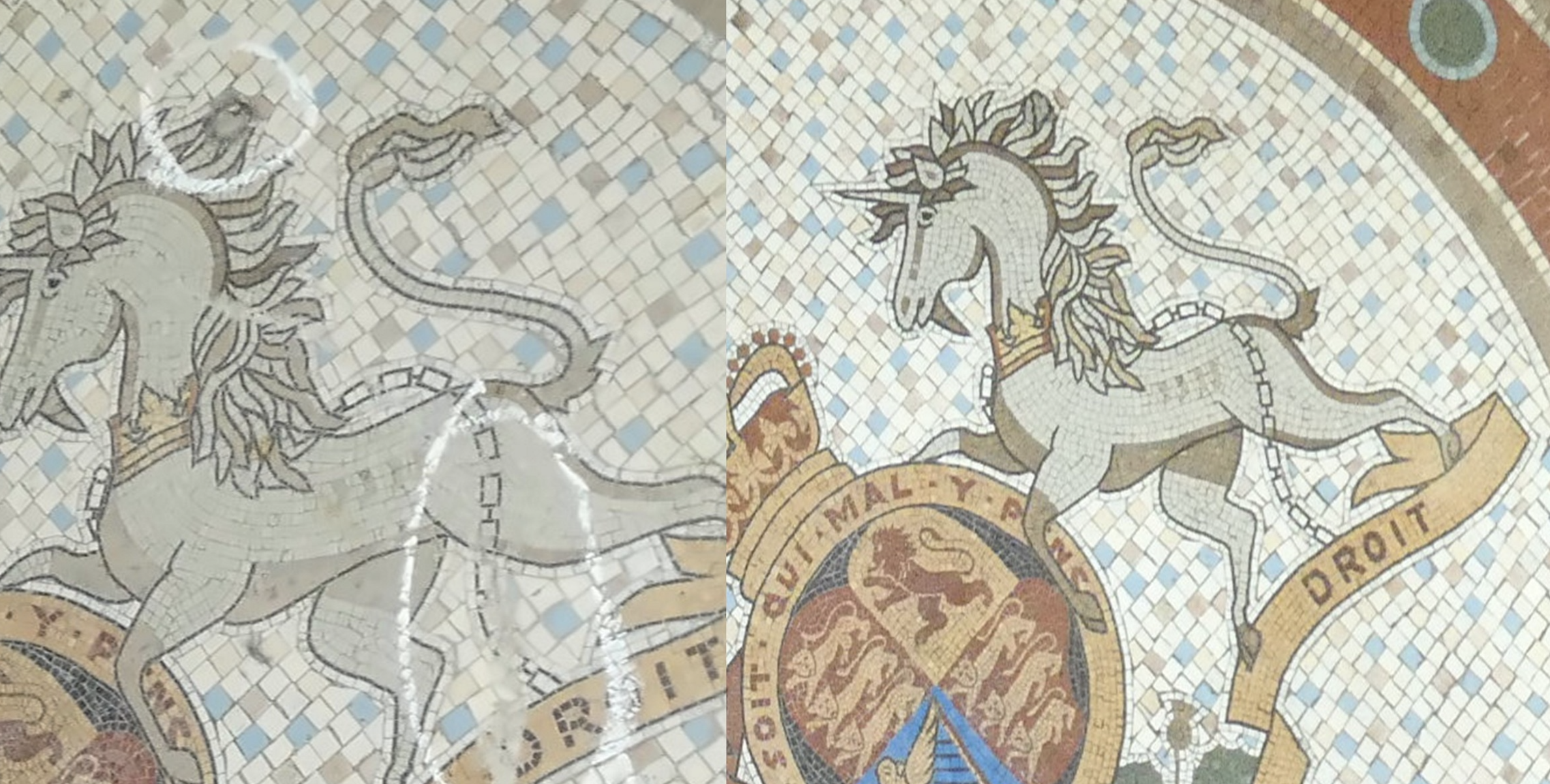Steve began his career as a stone carver but a contract that involved a badly damaged marble mosaic changed the course of his career. Finding this new niche, he became a Tyler-mason. In his youth, he travelled to other countries to restore mosaic floors before specialising in Victorian encaustic and geometric tile restoration. In 1982, he launched Heritage Tiling & Restoration.
How did you get into your profession, and would you describe it as a vocation?
I started out as an apprentice stonemason and was aiming to become a stone carver but when I discovered a badly damaged marble mosaic floor with massive patches of ruined marble, it changed my path. I was the youngest apprentice, and we were tasked with cutting new marble cubes known as tesserae to restore the damaged areas. The other lads didn’t have long to finish their apprenticeships, so they just botched the repairs. I made the best attempt and then was given the whole job. Bearing in mind that when the floor was installed it was by a 25 strong team from Italy. It took me nearly 3 years in between other work to restore the floors. By then I had cut nearly a million inch x inch cubes from various blocks of different coloured marble. Yes, I would say it is a vocation – that first restoration project meant a couple of years later I got called over to restore a mosaic floor in New York.

Steve and Sarah of Heritage Tiling and Restoration.
What surprises people about your job?
I think the main surprise is that I can actually restore these fabulous tiled floors. Sadly, WWI and WWII killed off most of the tile making companies and the tilers who installed them.
What’s the most exciting project you’ve ever worked on?
I’ve worked on projects that have NDC (non-disclosure clauses) but I can say I trained Māori people over in New Zealand. With regard to more permanent mosaic art, I have been on TV a few times and been involved in very long projects. The most enjoyable was a restoration project in the British Virgin Isles – the client insisted on me going fishing every day so that was great and so was the pay!
Where do you source your materials and are there any products you recommend?
I source marble from various companies and quarries across the world and during a project at Ullet Road Church in Liverpool, which is a Grade I listed building, I sourced the correct mix of tiles from three quarries. I use companies in France, Spain and Italy and also use smaller mosaics on sheets from Domus. We have a large stock of original Victorian encaustic (patterned tiles and geometric plain coloured tiles) too.
New tiles are sourced from Craven Dunnill Jackfield in Telford and Winckelmans in France. We clean the tiles using recycled pads made from Coca-Cola bottles that are infused with microscopic diamond dust and we use only water – we won an award for this approach as the water is safe to put back into the system. We often use adhesives that have a high percentage of recycled materials and our sealer is always Dry Treat – it’s the best sealer we have ever used and it can last decades.
I know you have an apprentice, Sarah Dodgson – how is it working together and how do you feel passing skills on?
Sarah is my best apprentice ever and is up for a Fellowship this year, I have high hopes for her and I expect her to take over when I either die or retire! I have trained people here and in other countries and some are still working in the field. At 30 years old, my website is the oldest in the world showing historic tile restoration and I have been working in this field for 52 years.

Before and after tile restoration.
You have visited a lot of countries, how does the work vary from country to country?
I completed a journeyman degree and I did ad hoc training with people from Morocco using traditional Zellige Islamic styles of pattern and glazes. Tangiers followed the same type of tiling with some more intricate patterns and the Iznik people produced fabulous works of art that can be found all over Turkey but especially in Anatolia. I also worked on some restoration at Anatolia Palace.
Do you have a dream project you’d love to work on?
Yes I do, it would be perhaps the culmination of my long decades if I could find a very rich client who wanted to have walls and floors tiled in mosaic, geometric and encaustic tiles in a variety of styles but I am not sure if that will ever happen! I would also like to restore the floors at Westminster Abbey.
Your hometown of Liverpool has the highest ratio of listed buildings outside London – what’s your favourite?
St George’s Hall floor is just stunning, I have worked on a small repair on this floor many years ago. The Liverpool Echo did an article about me as did the Financial Times highlighting how hard it is to find people with these skills.
Can you describe a typical day?
A typical day starts with loading up the vehicles and, as Sarah and I live a good distance from each other, we have checklists. We carry everything required for a project. Before Christmas we were in Crieff, Scotland, which is a five-hour drive, so we took more kit and materials than we needed, otherwise it would have been a severe problem having to drive back.
Not all jobs are that far away, we usually unpack what is required on the day and then have a brew. If we are working together we don’t always have music on; I always have music on if I’m working alone. Then we plan out our main course of action, which is usually to remove all damaged loose or broken tiles.
All our projects are surveyed sometimes months in advance and we take photos with cameras not mobile phones as we need to enlarge photos on decent-sized monitors as then the work can be evaluated correctly. Often we can come up with a ballpark figure based on the info sheet we send out. If our ballpark is in the client’s budget and the project is straightforward we can arrange a start date, otherwise we carry out a physical survey to make sure the parameters of the project fit in terms of time and money.
Often tiles are required to be made but some may already be in the Craven Dunnill Jackfield’s catalogue or the tiles might need a mould making, that can be very expensive and could mean a wait of months before the tiles are ready. Jobs can take a long time from start to finish.
We always need to juggle time to fit in work without cramming jobs too close together and also restoration work can throw up unforeseen problems. The uncertainty means I never get bored with my work. Plus being able to take very badly damaged floors that would be destined for the skip back to wonderful restored floors that will last another 100 plus years is very satisfying.
Are you worried that there is going to be a shortage of people who can do what you do? How can we fix that?
It is one of the most annoying things about my work as it is not recognised as a skillset – Google have doll restoration, teddy bear restoration and so on but Google will not add a category for tile restoration. I have tried for years to get this changed.
My skillset is often just ignored and on the Victorian reproduction tiling side, which is quite popular, there is a lack of training and I worry about the quality of work being done. Honestly, it hurts my eyes looking at some of the tiling carried out and I do a number of free second opinions every year.
To find out more, visit: https://heritagetiling.com
Sarah Dodgson runs Angel Tiling and can be contacted on angel171.sd@gmail.com or 07876 240875.
Please note this is an updated feature taken from the Summer 2024 issue of Stone Specialist.

